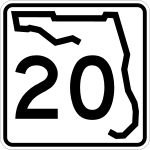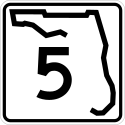Florida State Road 20
 | |
|---|---|
| Basisdaten | |
| Gesamtlänge: | 361,614 mi/581,96 km |
| Eröffnung: | 1945 |
| Bundesstaat: | Florida |
| Anfangspunkt: | |
| Endpunkt: | |
| Countys: | Okaloosa, Walton, Washington, Bay, Calhoun, Liberty, Leon, Jefferson, Madison, Taylor, Lafayette, Suwannee, Columbia, Alachua, Putnam, Flagler |
Die Florida State Road 20 (kurz FL 20) ist eine State Route im US-Bundesstaat Florida, die in West-Ost-Richtung verläuft. Sie beginnt in Niceville im Okaloosa County an der State Road 85 und endet in Bunnell im Flagler County am U.S. Highway 1 (FL 5).
Streckenverlauf
Die State Road beginnt in Niceville im Okaloosa County und führt westwärts an der Choctawhatchee Bay entlang, bevor sie den Choctawhatchee River und den Apalachicola River überquert, den Apalachicola National Forest durchquert und die Hauptstadt Tallahassee erreicht. Von hier bis High Springs begleitet der U.S. Highway 27 die Straße und überquert dabei den Aucilla River und den Suwannee River. Gemeinsam mit dem U.S. Highway 441 führt die Straße weiter über Alachua (wo die Interstate 75 gekreuzt wird) nach Gainesville. Die State Road führt weiter über Palatka, wo der St. Johns River gequert wird, und endet schließlich weiter südostwärts bei Bunnell im Flagler County.
Auf dieser Seite verwendete Medien
30 in by 24 in (750 mm by 600 mm) Florida State Road shield, made to the specifications of the sign detail. Uses the Roadgeek 2005 fonts. (United States law does not permit the copyrighting of typeface designs, and the fonts are meant to be copies of a U.S. Government-produced work anyway.) The outside border has a width of 1 (1/16 in) and a color of black so it shows up; in reality, signs have no outside border. Note that the drawing does not provide the border width or curve radii. (The previous page does but seems very inaccurate.) Thus those measurements are approximated from the drawing. The state outline is extracted from the PDF and cleaned up (to make the inside match the outside).
24 in by 24 in (600 mm by 600 mm) Florida State Road shield, made to the specifications of the sign detail. Uses the Roadgeek 2005 fonts. (United States law does not permit the copyrighting of typeface designs, and the fonts are meant to be copies of a U.S. Government-produced work anyway.) The outside border has a width of 1 (1/16 in) and a color of black so it shows up; in reality, signs have no outside border. Note that the drawing does not provide the border width or curve radii. (The previous page does but seems very inaccurate.) Thus those measurements are approximated from the drawing. The state outline is extracted from the PDF and cleaned up (to make the inside match the outside).
600 mm × 600 mm (24 in × 24 in) U.S. Highway shield, made to the specifications of the 2004 edition of Standard Highway Signs. (Note that there is a missing "J" label on the left side of the diagram.) Uses the Roadgeek 2005 fonts. (United States law does not permit the copyrighting of typeface designs, and the fonts are meant to be copies of a U.S. Government-produced work anyway.)
24 in by 24 in (600 mm by 600 mm) Florida State Road shield, made to the specifications of the sign detail. Uses the Roadgeek 2005 fonts. (United States law does not permit the copyrighting of typeface designs, and the fonts are meant to be copies of a U.S. Government-produced work anyway.) The outside border has a width of 1 (1/16 in) and a color of black so it shows up; in reality, signs have no outside border. Note that the drawing does not provide the border width or curve radii. (The previous page does but seems very inaccurate.) Thus those measurements are approximated from the drawing. The state outline is extracted from the PDF and cleaned up (to make the inside match the outside).
24 in by 24 in (600 mm by 600 mm) Florida State Road shield, made to the specifications of the sign detail. Uses the Roadgeek 2005 fonts. (United States law does not permit the copyrighting of typeface designs, and the fonts are meant to be copies of a U.S. Government-produced work anyway.) The outside border has a width of 1 (1/16 in) and a color of black so it shows up; in reality, signs have no outside border. Note that the drawing does not provide the border width or curve radii. (The previous page does but seems very inaccurate.) Thus those measurements are approximated from the drawing. The state outline is extracted from the PDF and cleaned up (to make the inside match the outside).




